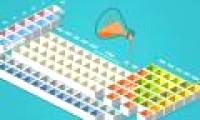
Each chemical element has its own name and symbol for easy identification.

The standard form of the table consists of elements arranged in 18 columns and 7 lines, with two separate dual lines located on the bottom.

At the end of January 2018, the magazine Chemical Communications published a very strange and interesting study.

About 14 billion years ago, the Big Bang explosion created a universe consisting of only gas, no stars nor any planets.

Accordingly, when Napoleon's army marched to Russia in June 1812, they were a powerful force with more than half a million soldiers.

The research team at the University of Florida, USA, discovered something surprising, that the last 21 elements in the periodic table do not follow the rules of quantum mechanics

Transforming ordinary metals like lead into rare and precious metals like gold is the wish of alchemists for a long time, but it still seems to be a long-term, distant dream.

A series of stars have long since disappeared, but the bismuth element will still exist and continue to decay.

Discovering a new element and placing it on the periodic table is no longer as easy as it used to be.

The research team at the Laboratory of Nuclear Reaction called Flerov (FLNR) in the famous scientific city of Dubna, Russia, has just stated: They have successfully replicated the
 Each chemical element has its own name and symbol for easy identification.
Each chemical element has its own name and symbol for easy identification. The standard form of the table consists of elements arranged in 18 columns and 7 lines, with two separate dual lines located on the bottom.
The standard form of the table consists of elements arranged in 18 columns and 7 lines, with two separate dual lines located on the bottom. At the end of January 2018, the magazine Chemical Communications published a very strange and interesting study.
At the end of January 2018, the magazine Chemical Communications published a very strange and interesting study. About 14 billion years ago, the Big Bang explosion created a universe consisting of only gas, no stars nor any planets.
About 14 billion years ago, the Big Bang explosion created a universe consisting of only gas, no stars nor any planets. Accordingly, when Napoleon's army marched to Russia in June 1812, they were a powerful force with more than half a million soldiers.
Accordingly, when Napoleon's army marched to Russia in June 1812, they were a powerful force with more than half a million soldiers. The research team at the University of Florida, USA, discovered something surprising, that the last 21 elements in the periodic table do not follow the rules of quantum mechanics
The research team at the University of Florida, USA, discovered something surprising, that the last 21 elements in the periodic table do not follow the rules of quantum mechanics Transforming ordinary metals like lead into rare and precious metals like gold is the wish of alchemists for a long time, but it still seems to be a long-term, distant dream.
Transforming ordinary metals like lead into rare and precious metals like gold is the wish of alchemists for a long time, but it still seems to be a long-term, distant dream. A series of stars have long since disappeared, but the bismuth element will still exist and continue to decay.
A series of stars have long since disappeared, but the bismuth element will still exist and continue to decay. Discovering a new element and placing it on the periodic table is no longer as easy as it used to be.
Discovering a new element and placing it on the periodic table is no longer as easy as it used to be. The research team at the Laboratory of Nuclear Reaction called Flerov (FLNR) in the famous scientific city of Dubna, Russia, has just stated: They have successfully replicated the
The research team at the Laboratory of Nuclear Reaction called Flerov (FLNR) in the famous scientific city of Dubna, Russia, has just stated: They have successfully replicated the




 NASA's 'Ninth Planet' Shows Signs of Being Friendly to Life
NASA's 'Ninth Planet' Shows Signs of Being Friendly to Life Why did American astronauts have to be quarantined when returning to Earth?
Why did American astronauts have to be quarantined when returning to Earth? China surprises the world by building a cable-stayed bridge 'above the clouds'
China surprises the world by building a cable-stayed bridge 'above the clouds' Why do women sleep less and wake up more than men?
Why do women sleep less and wake up more than men? Revealing the secret inside the stuffed animal claw machine, from there, summarizing experience to help you increase your winning rate many times over
Revealing the secret inside the stuffed animal claw machine, from there, summarizing experience to help you increase your winning rate many times over What would happen if you dug a hole through the Earth and jumped in?
What would happen if you dug a hole through the Earth and jumped in? Camera takes a photo that lasts 1,000 years
Camera takes a photo that lasts 1,000 years Was there nuclear war in ancient times?
Was there nuclear war in ancient times?